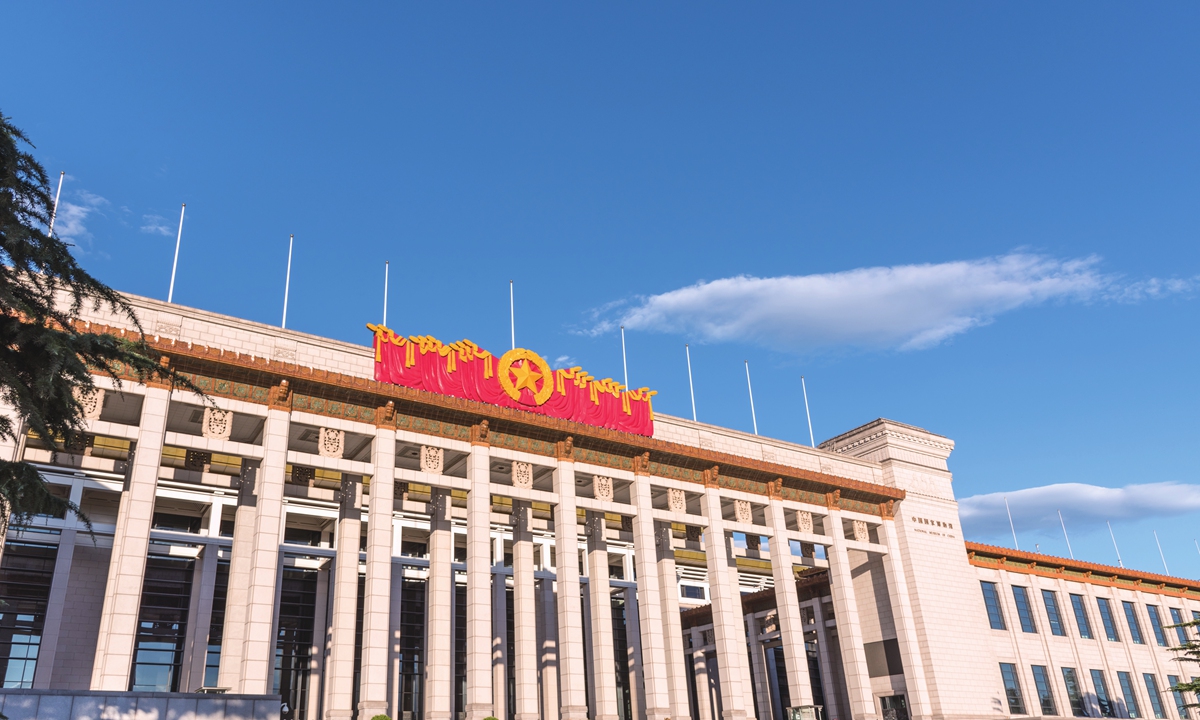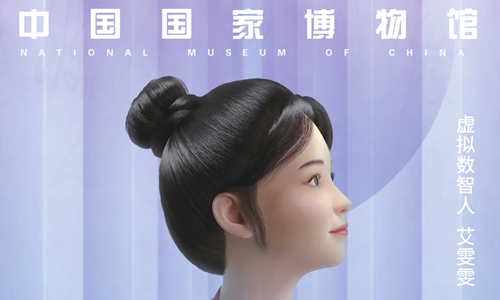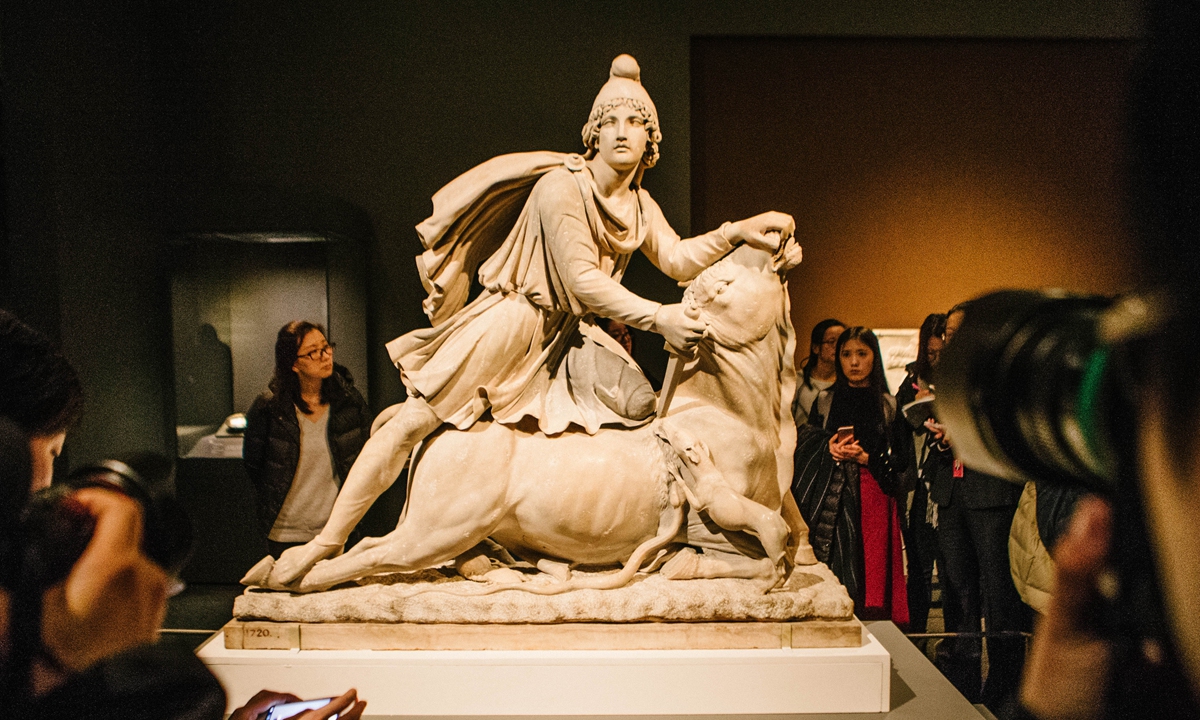
The National Museum of China in Beijing Photo: VCG
Editor's Note:In a letter replying to senior experts at the National Museum of China (NMC) on Friday, the institution's 110th anniversary, Chinese President Xi Jinping stressed that cultural relics need to be better utilized to preserve the accomplishments of Chinese civilization and promote cultural exchanges and mutual learning between civilizations.
Since it reopened to the public in 2012 after a long period of remodeling and expansion, the NMC has grown into one of the world's major museums. It has more than 1.4 million items in its collection, hosts international exhibitions in collaboration with major overseas institutions such as the British Museum, and implements programs to get people, especially young people, interested in Chinese culture.
It was drizzling in Beijing on Sunday. However, hundreds of people were still willing to line up outside the National Museum of China, located on the east side of Tiananmen Square, despite the foul weather.
Visitors were anxious to see famous national treasures such as the Houmuwu Ding, formerly known as the Simuwu Square Cauldron - the world's heaviest ancient bronze vessel - or be the first ones to see the NMC's newest exhibition on ancient Rome, a key project marking 2022's China-Italy Travel and Cultural Year.
"Chinese museums, especially the NMC, are using every means possible to help strengthen the public's interest in our culture," Chen Lüsheng, who worked as the NMC deputy president in 2010-16, told the Global Times on Sunday.
National treasures From the teeth of Yuanmou Man, the earliest human in China, and the Oracle bone script, the ancestor of modern Chinese characters, to cultural treasures such as books, paintings and more, the relics at the NMC provide visitors the opportunity to see with their own eyes how Chinese history has developed from its origins more than 5,000 years ago to today.
As one of the world's oldest living civilizations, Chinese civilization is not only important to people living in China, but also "a precious treasure that belongs to the world, as it learns about the wisdom and accomplishments of ancient people," noted Chen, who still works with the NMC as a consultant.
Not limited to ancient history, the museum is also home to items that document China's difficult road to building a better nation including the first Chinese version of
The Communist Manifesto, the five-star national flag used during the founding ceremony for the People's Republic of China and even the pen used to sign Beijing's bid for the 2008 Summer Olympics.
Overseas exchanges As China's top-notch cultural institution, the NMC has always embraced world civilizations by collaborating with international museums such as the UK's prestigious British Museum and Victoria and Albert Museum.
In 2012, a year before UK Prime Minister David Cameron visited the NMC, the three museums co-launched the exhibition
Passion for Porcelain, which displayed 148 ceramic treasures from both the UK and China to symbolize how the two countries' ceramic culture acted as a magnet bringing the two countries closer.
In 2017, the NMC's renowned exhibition
A History of the World in 100 Objects brought 100 items selected from the British Museum's collection of more than 8 million items to Chinese audiences.
In 2015, a statue of former French president Charles de Gaulle was donated to the NMC to celebrate 50 years of China-France diplomatic relations.
"When one national-museum is bound with other national-level cultural institution, an exhibition not only shows the Western art world's respect for Chinese culture, but also demonstrates art's diplomatic ability to draw two countries closer through culture," Kuang Yong, an expert on the global development of Chinese art, told the Global Times on Sunday.
Young and chic When it comes to innovation, Chinese museums have led industry by incorporating the latest advancements in AI, VR and more. For instance, on Saturday, the NMC released its first AI "staff member" Ai Wenwen, a digital tour guide that takes visitors on a walk through the history of Chinese civilization.
"Museums at both the national and local levels have contributed to public education through activities such as holding seminars for schools in various cities and digital efforts such as introducing AI robots to the public," Wang Wei, chief expert of the National Research Program into the Origin of Chinese Civilization, told the Global Times.
Since 2016, Chinese museums have also started to develop various creative products in the hope of establishing closer ties between museums and young people. In 2018, the NMC launched five limited-edition lipsticks based on five historic Chinese beauties. The limited series was a huge hit, selling out almost immediately.
Compared with overseas museums that are several hundred years old, the 110-year-old NMC is comparatively young, but it is still doing all it can to carry on the mission of more effectively using cultural relics to preserve the accomplishments of Chinese civilization and promote exchanges and mutual learning between civilizations.

NMC's AI "staff member" Ai Wenwen Photo: Courtesy of NMC

People visit A History of the World in 100 Objects at the NMC in March 2017. Photo: Li Hao/GT






